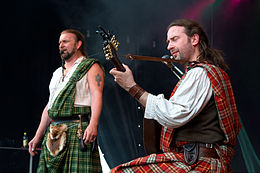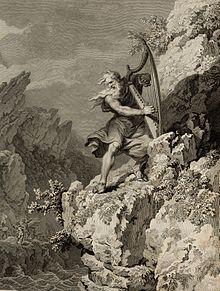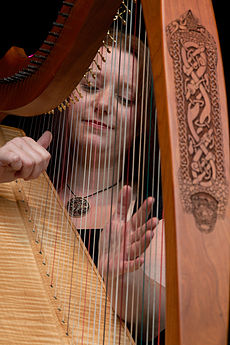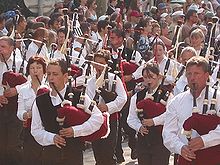Celtic music

Celtic musicis a broad grouping ofmusic genresthat evolved out of thefolk musictraditions of theCeltic peopleofNorthwestern Europe(the modernCeltic nations).[1][2]It refers to both orally-transmitted traditional music and recorded music and the styles vary considerably to include everything from traditional music toa wide range of hybrids.
Description and definition[edit]

This section has multiple issues.Please helpimprove itor discuss these issues on thetalk page.(Learn how and when to remove these template messages)
|
Celtic musicmeans two things mainly. First, it is the music of the people that identify themselves asCelts.Secondly, it refers to whatever qualities may be unique to the music of theCeltic nations.Many notable Celtic musicians such asAlan StivellandPaddy Moloney[3]claim that the different Celtic music genres have a lot in common.[1][2][4]
These following melodic practices may be used[4]widely across the different variants of Celtic Music:

- It is common for the melodic line to move up and down the primary chords in many Celtic songs. There are a number of possible reasons for this:
- Melodic variationcan be easily introduced. Melodic variation is widely used in Celtic music, especially by the pipes and harp.
- It is easier to anticipate the direction that the melody will take, so that harmony either composed or improvised can be introduced: clichéd cadences that are essential for impromptu harmony are also more easily formed.
- The relatively wider tonal intervals in some songs make it possible for stress accents within the poetic line to be more in keeping with the local Celtic accent.
- Across just one Celtic group.
- By more than one Celtic language population belonging to different Celtic groups.
These two latter usage patterns may simply be remnants of formerly widespread melodic practices.
Often, the termCeltic musicis applied to themusic of IrelandandScotlandbecause both lands have produced well-known distinctive styles which actually have genuine commonality and clear mutual influences. The definition is further complicated by the fact that Irish independence has allowed Ireland to promote 'Celtic' music as a specifically Irish product. However, these are modern geographical references to a people who share a common Celtic ancestry and consequently, a common musical heritage.
These styles are known because of the importance of Irish and Scottish people in the English speaking world, especially in the United States, where they had a profound impact onAmerican music,particularlybluegrassandcountry music.[5]Themusic of Wales,Cornwall,theIsle of Man,Brittany,Galician traditional music(Spain) andmusic of Portugalare also considered Celtic music, the tradition being particularly strong inBrittany,[6]where Celtic festivals large and small take place throughout the year,[7]and in Wales, where the ancienteisteddfodtradition has been revived and flourishes. Additionally, the musics of ethnically Celtic peoples abroad are vibrant, especiallyin Canadaand theUnited States.In Canada the provinces of Atlantic Canada are known for being a home of Celtic music, most notably on the islands of Newfoundland, Cape Breton and Prince Edward Island. The traditional music of Atlantic Canada is heavily influenced by the Irish, Scottish and Acadian ethnic makeup of much of the region's communities.[8]In some parts of Atlantic Canada, such as Newfoundland, Celtic music is as or more popular than in the old country. Further, some older forms of Celtic music that are rare in Scotland and Ireland today, such as the practice of accompanying a fiddle with a piano, or the Gaelic spinning songs of Cape Breton remain common in the Maritimes. Much of the music of this region is Celtic in nature, but originates in the local area and celebrates the sea, seafaring, fishing and other primary industries.
Instruments associated with Celtic Music include theCeltic harp,uilleann pipesorGreat Highland bagpipe,fiddle,tin whistle,flute,bodhrán,bones,concertina,accordionand a recent addition, theIrish bouzouki.[9]
Divisions[edit]

InCeltic Music: A Complete Guide,June Skinner Sawyers acknowledges sixCeltic nationalitiesdivided into two groups according to their linguistic heritage.[10]TheQ-Celticnationalities are the Irish, Scottish andManx peoples,while theP-Celticgroups are theCornish,BretonsandWelsh peoples.MusicianAlan Stivelluses a similar dichotomy, between theGaelic(Irish/Scottish/Manx) and theBrythonic(Breton/Welsh/Cornish) branches, which differentiate "mostly by the extended range (sometimes more than two octaves) of Irish and Scottish melodies and the closed range of Breton and Welsh melodies (often reduced to a half-octave), and by the frequent use of the purepentatonic scalein Gaelic music. "[11]
There is also tremendous variation betweenCelticregions. Ireland, Scotland, Wales, Cornwall, and Brittany have living traditions of language and music, and there has been a recent major revival of interest in Celtic heritage in the Isle of Man.Galiciahas a Celtic language revival movement to revive the Q-CelticGallaic languageused into Roman times,[12][13][14][15]which is not anattested language,[16]unlikeCeltiberian.ABrythonic languagemay have been spoken in parts of Galicia andAsturiasinto early Medieval times brought by Britons fleeing the Anglo-Saxon invasions viaBrittany.,[17][18]but here again there are several hypotheses and very little traces of it: lack of archeological, linguistic evidence and documents.[19]TheRomance languagecurrently spoken in Galicia,Galician(Galego) is closely related to thePortuguese languageused mainly in Brazil and Portugal and in many ways closer to Latin than other Romance languages.[16]Galician music is claimed to beCeltic.[2]The same is true of the music of Asturias,[2]Cantabria,and that of NorthernPortugal(some say even traditional music from Central Portugal can be labeled Celtic).
BretonartistAlan Stivellwas one of the earliest musicians to use the wordCelticandKeltiain his marketing materials, starting in the early 1960s as part of the worldwide folk music revival of that era[20][21]with the term quickly catching on with other artists worldwide. Today, the genre is well established andincredibly diverse.
Forms[edit]
There are musical genres and styles specific to each Celtic country, due in part to the influence of individual song traditions and the characteristics of specific languages:[22]
- Celtic traditional music
- Music of Ireland
- Music of Scotland
- Music of Wales
- Strathspeysare specific to Highland Scotland and Cape Breton, for example, and it has been hypothesized that they mimic the rhythms of theScottish Gaeliclanguage.[23]
- Reels
- Pibroch
- Cerdd Dant(string music) orCanu Penillion(verse singing) is the art of vocal improvisation over a givenmelodyin Welsh musical tradition. It is an important competition ineisteddfodau.The singer or (small)choirsings a counter melody over aharpmelody.[24]
- Waulking song
- Puirt à beul
- Kan ha diskan
- Sean-nós singing
- Celtic hip hop
- Celtic rock
- Celtic metal
- Celtic punk
- Celtic fusion
- Progressive music
- Folk music
Festivals[edit]
- Seelist of Celtic festivalsfor a more complete list ofCeltic festivalsby country, including music festivals. Festivals focused largely or partly on Celtic music can be found atCategory:Celtic music festivals.
The modern Celtic music scene involves a large number ofmusic festivals,as it has traditionally. Some of the most prominent festivals focused solely on music include:
- Festival Internacional do Mundo Celta de Ortigueira(Ortigueira,Galicia,Spain)
- Festival Intercéltico de Avilés(Avilés,Asturies,Spain)
- Folixa na Primavera(Mieres,Asturies,Spain)
- Festival Celta Internacional Reino de León,(León,Spain)
- Festival Internacional de Música Celta de Collado Villalba(Collado Villalba,Spain)
- Yn Chruinnaght(Isle of Man)
- Celtic Connections(Glasgow,Scotland)[25]
- Hebridean Celtic Festival(Stornoway,Scotland)[26]

- Fleadh ceol na hÉireann(Tullamore,Ireland)
- Festival Intercéltico de Sendim(Sendim, Portugal)[27][28]
- Galaicofolia(Esposende,Portugal)[29]
- Festival FolkCelta Ponte da Barca (Ponte da Barca,Portugal)
- Douro Celtic Fest(Vila Nova de Gaia,Portugal)
- Festival Interceltique de Lorient(Lorient,France)[30]
- Festival del Kan ar Bobl(Lorient,France)
- Festival de Cornouaille(Quimper,France)
- Les Nuits Celtiques du Stade de France(Paris,France)
- Montelago Celtic Night(Colfiorito,Macerata,Italy)
- Triskell International Celtic Festival(Trieste,Italy)
- Festival celtique de Québec or Québec city celtic festival, (Quebec City,Quebec,Canada)[31]
- Festival Mémoire et Racines(Saint-Charles-Borromée,Quebec,Canada)
- Celtic Colours(Cape Breton, Nova Scotia, Canada)
- Paganfest(Tour through Europe)
Celtic fusion[edit]
The oldest musical tradition which fits under the label of Celtic fusion originated in the rural American south in the early colonial period and incorporated English, Scottish, Irish, Welsh, German, and African influences. Variously referred to as roots music, American folk music, orold-time music,this tradition has exerted a strong influence on all forms of American music, including country, blues, and rock and roll.[32]In addition to its lasting effects on other genres, it marked the first modern large-scale mi xing of musical traditions from multiple ethnic and religious communities within theCeltic diaspora.
In the 1960s several bands put forward modern adaptations of Celtic music pulling influences from several of the Celtic nations at once to create a modernpan-celticsound. A few of those includebagadoù (Breton pipe bands),Fairport Convention,Pentangle,Steeleye SpanandHorslips.
In the 1970sClannad[33]made their mark initially in thefolkand traditional scene, and then subsequently went on to bridge the gap between traditional Celtic and pop music in the 1980s and 1990s, incorporating elements fromnew-age,smooth jazz,andfolk rock.Traces of Clannad's legacy can be heard in the music of many artists, includingAltan,Anúna,Capercaillie,the Corrs,Dexys Midnight Runners,Enya,Loreena McKennitt,Riverdance,Donna Taggart,andU2.The solo music of Clannad's lead singer,Moya Brennan(often referred to as the First Lady of Celtic Music) has further enhanced this influence.
Later, beginning in 1982 withthe Pogues' invention of Celtic folk-punk andStockton's Wingblend of Irish traditional and Pop, Rock and Reggae, there has been a movement to incorporateCelticinfluences into other genres of music. Bands likeFlogging Molly,Black 47,Dropkick Murphys,the Young Dubliners,the Tossersintroduced a hybrid ofCeltic rock,punk,reggae,hardcoreand other elements in the 1990s that has become popular with Irish-American youth.
Today there are Celtic-influenced subgenres of virtually every type of popular music includingelectronica,rock,metal,punk,hip hop,reggae,new-age,Latin,Andeanandpop.Collectively these modern interpretations of Celtic music are sometimes referred to asCeltic fusion.
Other modern adaptations[edit]
Outside of America, the first deliberate attempts to create a "Pan-Celtic music" were made by the BretonTaldir Jaffrennou,having translated songs from Ireland, Scotland, and Wales into Breton between the two world wars. One of his major works was to bring "Hen Wlad Fy Nhadau"(the Welshnational anthem) back in Brittany and create lyrics in Breton. Eventually this song became "Bro goz va zadoù"(" Old land of my fathers ") and is the most widely accepted Breton anthem. In the 70s, the BretonAlan Cochevelou(futureAlan Stivell) began playing a mixed repertoire from the main Celtic countries on the Celtic harp his father created.[21]
Probably the most successful all-inclusive Celtic music composition in recent years isShaun DaveyscompositionThe Pilgrim.This suite depicts the journey of St. Colum Cille through the Celtic nations of Ireland, Scotland, theIsle of Man,Wales,Cornwall,BrittanyandGalicia.The suite which includes a Scottish pipe band, Irish and Welsh harpists,Galician gaitas,Irishuilleann pipes,thebombardesofBrittany,two vocal soloists and a narrator is set against a background of a classical orchestra and a large choir.
Modern music may also be termed "Celtic" because it is written and recorded in a Celtic language, regardless of musical style. Many of the Celtic languages have experienced resurgences in modern years, spurred on partly by the action of artists and musicians who have embraced them as hallmarks of identity and distinctness. In 1971, the Irish bandSkara Braerecorded its onlyLP(simply calledSkara Brae), all songs in Irish. In 1978Runrigrecorded an album inScottish Gaelic.In 1992Capercaillierecorded "A Prince Among Islands", the first Scottish Gaelic language record to reach the UK top 40. In 1996, a song in Breton represented France in the41st Eurovision Song Contest,the first time in history that France had a song without a word in French. Since about 2005,Oi Polloi(from Scotland) have recorded in Scottish Gaelic.Mill a h-Uile Rud(aScottish Gaelic punkband from Seattle) recorded in the language in 2004.
Several contemporary bands have Welsh language songs, such asCeredwen,which fuses traditional instruments withtrip hopbeats, theSuper Furry Animals,Fernhill,and so on (see theMusic of Walesarticle for more Welsh and Welsh-language bands). The same phenomenon occurs in Brittany, where many singers record songs in Breton, traditional or modern (hip hop,rap,and so on.).
See also[edit]
- Folk music of Ireland
- Music of Brittany
- Music of Cornwall
- Galician traditional music
- Music of the Isle of Man
- Music of Scotland
- Music of Wales
- Music of Portugal
- Traditional Gaelic music
References[edit]
- ^abMelhuish, Martin (1998).Celtic Tides: Traditional Music in a New Age.Ontario, Canada: Quarry Press Inc. pp. 8, 28.ISBN1-55082-205-5.
- ^abcdAlberro, Manuel (2005)."Celtic Legacy in Galicia".E-Keltoi: Journal of Interdisciplinary Celtic Studies.6:1005–1035. Archived fromthe originalon 1 June 2013.Retrieved16 August2011.
- ^Melhuish, Martin (1998).Celtic Tides: Traditional Music in a New Age.Ontario, Canada: Quarry Press Inc. pp. 73–79 especially 77 and 79.ISBN1-55082-205-5.
- ^abAubrey, Graham (2011).The Ingenious Cornish – Inventions, Enterprises and Exploits: The Ethnicity Factor in Cornish Music Both at Home and Abroad.Wallaroo Town Hall during Kernewek Lowender 2011 Biennial Seminar: Cornish Association of South Australia Est. 1890. p. 16.
{{cite book}}:CS1 maint: location (link) - ^Troxler, Bill (14 October 2007)."From Heather to High Lonesome".Bluegrass and Celtic Music.Chincoteague Cultural Alliance. Archived fromthe originalon 28 August 2008.
- ^"What is celtic music?".ceolas.org.Retrieved18 September2017.
- ^Defrance Yves, "New Celtic Music in Brittany", in Continuum Encyclopedia of popular music of the world, London-New York, International Association of Popular Music, Continuum Books, Part.3 Genres, vol.10, 2013, 3 p.
- ^Melhuish, Martin (1998).Celtic Tides: Traditional Music in a New Age.Ontario, Canada: Quarry Press Inc. pp. 121–152.ISBN1-55082-205-5.
- ^"Classic Celtic Instruments".Celtic Life International.Retrieved29 July2023.
- ^Sawyers, June Skinner (2000).Celtic Music: A Complete Guide(1st Da Capo Press ed.). New York:Da Capo Press.p. 4.ISBN0-306-81007-7.Retrieved25 March2016.
- ^translation by Steve Winick
- ^"Celtic Music – Celtic Music Instruments".13 July 2016.Retrieved10 August2016.
- ^"Gallaic Revival".Archived fromthe originalon 7 January 2018.Retrieved11 May2013.
- ^"Gallaic Revival Movement".Retrieved11 May2013.
- ^"Gallaic Revival Movement"."Gallaic Revival Movement Home Page".Archived from the original on 2 October 2012.Retrieved11 May2013.
{{cite web}}:CS1 maint: bot: original URL status unknown (link) - ^abConsello da cultura Galega, FROM THE ORIGINS TO THE RENAISSANCE (6TH CENTURY TO 1475)[1]"
- ^Koch, John(2005).Celtic Culture: A Historical Encyclopedia.ABL-CIO. p. 275.ISBN978-1-85109-440-0.Retrieved29 September2012.
- ^Zimmer with Koch and Minard (eds.), Stefan with John T. and Antone (2012).The Celts: History, Life, and Culture – see map of Celtic language distribution.California: ABC-CLIO, LLC. p. 162.ISBN978-1-59884-964-6.
{{cite book}}:|last=has generic name (help) - ^"(...) Bishop Mailoc, the only Britonian prelate who has a Celtic name ( =" great "). The other known bishops always bear Latin or Germanic names.(...)" in José Miguel Novo Güisán,Los pueblos vasco-cantábricos y galaicos en la Antigüedad Tardía, siglos III-IX,Universidad de Alcalá de Henares, Servicio de Publicaciones, 1992.
- ^Bruce Elder. All Music Guide,Answers.Retrieved 15 July 2009.
- ^abJT Koch (ed). Celtic Culture. A Historical Encyclopaedia ABC-CLIO 2006 pp 1627–1628
- ^"Celtic Music Genre Overview | AllMusic".AllMusic.Retrieved18 September2017.
- ^Cockburn, Craig."Traditional Gaelic song and singing sean-nós".Silicon Glen.Retrieved25 March2016.
- ^"About Cerdd Dant".Cymdeithas Cerdd Dant Cymru. Archived fromthe originalon 16 December 2010.Retrieved5 May2012.
- ^"Celtic connections:Scotland's premier winter music festival".Celtic connections website.Celtic Connections.2010.Retrieved23 January2010.
- ^"Hebridean Celtic Festival 2010 – the biggest homecoming party of the year".Hebridean Celtic Festival website.Hebridean Celtic Festival.2009.Retrieved23 January2010.
- ^"IntercelticoSendim".Archived fromthe originalon 27 December 2008.
- ^"Festival Intercéltico de Sendim 2015".Douro Valley. August 2015.Retrieved25 March2016.
- ^"Galaicofolia".Retrieved25 March2016.
- ^"Site Officiel du Festival Interceltique de Lorient".Festival Interceltique de Lorient website.Festival Interceltique de Lorient.2009. Archived fromthe originalon 5 March 2010.Retrieved23 January2010.
- ^"Festival Celtique de Québec".2012.Retrieved2 July2012.
- ^Irish Folk, Trad and Blues: A Secret History "by Colin Harper (2005) covers Horslips, The Pogues, Planxty and others.
- ^"Clannad | Biography, Albums, Streaming Links".AllMusic.


